St George’s Market is one of Belfast’s oldest attractions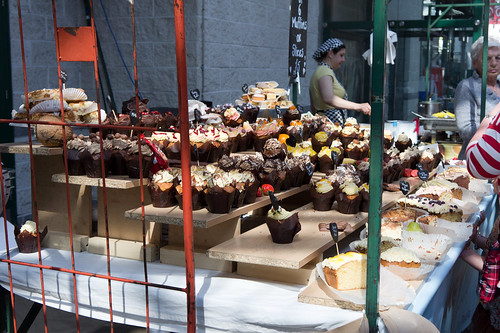
Image by infomatique
This was one of the highlights of my visit to Belfast.
St George’s Market is one of Belfast’s oldest attractions. It was built between 1890 and 1896 and is one of the best markets in the UK and Ireland. It holds a market on Friday, Saturday and Sunday each week. The market sells a variety of products including food, clothes, books and antiques.
St George's Market is the last surviving Victorian covered market in Belfast, Northern Ireland. It is located on May Street, close to the River Lagan and the Waterfront Hall and Central Railway station.
Belfast Corporation (now Belfast City Council) commissioned the building of St George’s Market, which was built in three phases between 1890 and 1896. Before 1890 St George's Market was an open market and most likely contained a slaughterhouse and a meat market.
The original (pre 1890) market was smaller than the new structure. The city surveyor (responsible for the new Albert Bridge following its collapse in the 1880s) JC Bretland designed the building. It was built in red brick with sandstone dressing. Externally it features Roman styled arches with Latin and Irish inscriptions - the City’s Latin motto "Pro Tanto Quid Retribuamus", meaning "what shall we give in return for so much?" and the Irish phrase "Lámh Dearg na hÉireann", "Red Hand of Ireland". The main entrance arch displays the Belfast Coat of Arms. This newly covered market opened to the public on 20 June 1890.
By the 1980s St George’s Market had developed into a general market and it became the last of Belfast’s thriving Victorian markets. The market was pressured with increased maintaince costs and changes to hygiene regulations, among other issues, and Belfast City Council decided to source other uses for the listed building. A campaign backed by the City Council, traders and the general public resulted in a Heritage Lottery Fund-backed £3.5 million refurbishment programme assisted by the Environment and Heritage Agency. Brick and stonework that had badly deteriorated was returned to good condition, and special bricks were produced in England to match the original unusually sized bricks. The fully renovated St George’s Market reopened its doors on 14 May 1999.
St George’s Market is primarily used as a market, however a number of other events are held at the site. These range from food festivals, art initiatives, exhibitions, charity launches, fashion shoots and live music events. Local software company Northbrook Technology hold their annual Staff Christmas Party at the venue.
The market has won a number of recent awards, including being voted as one of the UK's top five markets by the National Association of British Market Authorities in 2006, and winning third place in the best markets category of the Observer Food Monthly/Waitrose Awards in 2004.
The market has also been praised as a place that transcends the divide between Belfast's communities, and where immigrant groups can feel safe, in contrast to other areas of the city where racist attacks are not uncommon.
St George’s Market is one of Belfast’s oldest attractions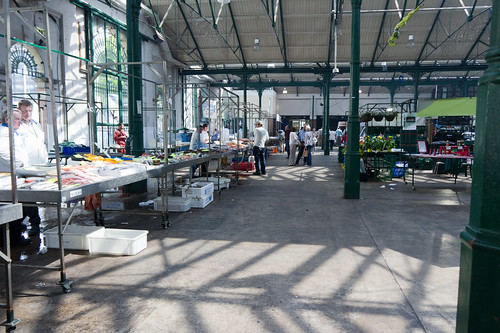
Image by infomatique
This was one of the highlights of my visit to Belfast.
St George’s Market is one of Belfast’s oldest attractions. It was built between 1890 and 1896 and is one of the best markets in the UK and Ireland. It holds a market on Friday, Saturday and Sunday each week. The market sells a variety of products including food, clothes, books and antiques.
St George's Market is the last surviving Victorian covered market in Belfast, Northern Ireland. It is located on May Street, close to the River Lagan and the Waterfront Hall and Central Railway station.
Belfast Corporation (now Belfast City Council) commissioned the building of St George’s Market, which was built in three phases between 1890 and 1896. Before 1890 St George's Market was an open market and most likely contained a slaughterhouse and a meat market.
The original (pre 1890) market was smaller than the new structure. The city surveyor (responsible for the new Albert Bridge following its collapse in the 1880s) JC Bretland designed the building. It was built in red brick with sandstone dressing. Externally it features Roman styled arches with Latin and Irish inscriptions - the City’s Latin motto "Pro Tanto Quid Retribuamus", meaning "what shall we give in return for so much?" and the Irish phrase "Lámh Dearg na hÉireann", "Red Hand of Ireland". The main entrance arch displays the Belfast Coat of Arms. This newly covered market opened to the public on 20 June 1890.
By the 1980s St George’s Market had developed into a general market and it became the last of Belfast’s thriving Victorian markets. The market was pressured with increased maintaince costs and changes to hygiene regulations, among other issues, and Belfast City Council decided to source other uses for the listed building. A campaign backed by the City Council, traders and the general public resulted in a Heritage Lottery Fund-backed £3.5 million refurbishment programme assisted by the Environment and Heritage Agency. Brick and stonework that had badly deteriorated was returned to good condition, and special bricks were produced in England to match the original unusually sized bricks. The fully renovated St George’s Market reopened its doors on 14 May 1999.
St George’s Market is primarily used as a market, however a number of other events are held at the site. These range from food festivals, art initiatives, exhibitions, charity launches, fashion shoots and live music events. Local software company Northbrook Technology hold their annual Staff Christmas Party at the venue.
The market has won a number of recent awards, including being voted as one of the UK's top five markets by the National Association of British Market Authorities in 2006, and winning third place in the best markets category of the Observer Food Monthly/Waitrose Awards in 2004.
The market has also been praised as a place that transcends the divide between Belfast's communities, and where immigrant groups can feel safe, in contrast to other areas of the city where racist attacks are not uncommon.
St George’s Market is one of Belfast’s oldest attractions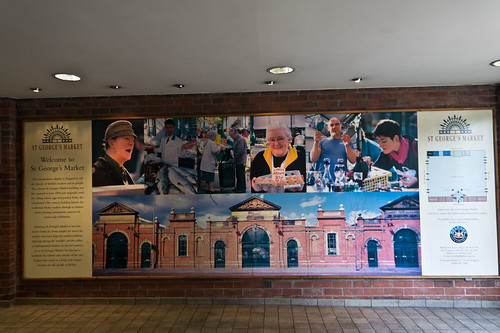
Image by infomatique
This was one of the highlights of my visit to Belfast.
St George’s Market is one of Belfast’s oldest attractions. It was built between 1890 and 1896 and is one of the best markets in the UK and Ireland. It holds a market on Friday, Saturday and Sunday each week. The market sells a variety of products including food, clothes, books and antiques.
St George's Market is the last surviving Victorian covered market in Belfast, Northern Ireland. It is located on May Street, close to the River Lagan and the Waterfront Hall and Central Railway station.
Belfast Corporation (now Belfast City Council) commissioned the building of St George’s Market, which was built in three phases between 1890 and 1896. Before 1890 St George's Market was an open market and most likely contained a slaughterhouse and a meat market.
The original (pre 1890) market was smaller than the new structure. The city surveyor (responsible for the new Albert Bridge following its collapse in the 1880s) JC Bretland designed the building. It was built in red brick with sandstone dressing. Externally it features Roman styled arches with Latin and Irish inscriptions - the City’s Latin motto "Pro Tanto Quid Retribuamus", meaning "what shall we give in return for so much?" and the Irish phrase "Lámh Dearg na hÉireann", "Red Hand of Ireland". The main entrance arch displays the Belfast Coat of Arms. This newly covered market opened to the public on 20 June 1890.
By the 1980s St George’s Market had developed into a general market and it became the last of Belfast’s thriving Victorian markets. The market was pressured with increased maintaince costs and changes to hygiene regulations, among other issues, and Belfast City Council decided to source other uses for the listed building. A campaign backed by the City Council, traders and the general public resulted in a Heritage Lottery Fund-backed £3.5 million refurbishment programme assisted by the Environment and Heritage Agency. Brick and stonework that had badly deteriorated was returned to good condition, and special bricks were produced in England to match the original unusually sized bricks. The fully renovated St George’s Market reopened its doors on 14 May 1999.
St George’s Market is primarily used as a market, however a number of other events are held at the site. These range from food festivals, art initiatives, exhibitions, charity launches, fashion shoots and live music events. Local software company Northbrook Technology hold their annual Staff Christmas Party at the venue.
The market has won a number of recent awards, including being voted as one of the UK's top five markets by the National Association of British Market Authorities in 2006, and winning third place in the best markets category of the Observer Food Monthly/Waitrose Awards in 2004.
The market has also been praised as a place that transcends the divide between Belfast's communities, and where immigrant groups can feel safe, in contrast to other areas of the city where racist attacks are not uncommon.
St George’s Market is one of Belfast’s oldest attractions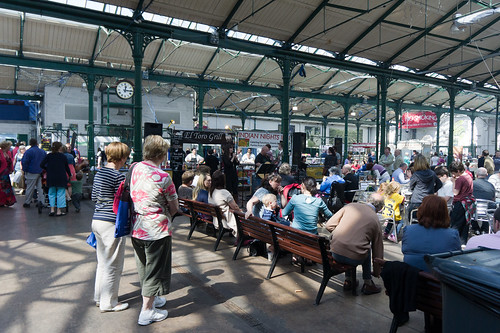
Image by infomatique
This was one of the highlights of my visit to Belfast.
St George’s Market is one of Belfast’s oldest attractions. It was built between 1890 and 1896 and is one of the best markets in the UK and Ireland. It holds a market on Friday, Saturday and Sunday each week. The market sells a variety of products including food, clothes, books and antiques.
St George's Market is the last surviving Victorian covered market in Belfast, Northern Ireland. It is located on May Street, close to the River Lagan and the Waterfront Hall and Central Railway station.
Belfast Corporation (now Belfast City Council) commissioned the building of St George’s Market, which was built in three phases between 1890 and 1896. Before 1890 St George's Market was an open market and most likely contained a slaughterhouse and a meat market.
The original (pre 1890) market was smaller than the new structure. The city surveyor (responsible for the new Albert Bridge following its collapse in the 1880s) JC Bretland designed the building. It was built in red brick with sandstone dressing. Externally it features Roman styled arches with Latin and Irish inscriptions - the City’s Latin motto "Pro Tanto Quid Retribuamus", meaning "what shall we give in return for so much?" and the Irish phrase "Lámh Dearg na hÉireann", "Red Hand of Ireland". The main entrance arch displays the Belfast Coat of Arms. This newly covered market opened to the public on 20 June 1890.
By the 1980s St George’s Market had developed into a general market and it became the last of Belfast’s thriving Victorian markets. The market was pressured with increased maintaince costs and changes to hygiene regulations, among other issues, and Belfast City Council decided to source other uses for the listed building. A campaign backed by the City Council, traders and the general public resulted in a Heritage Lottery Fund-backed £3.5 million refurbishment programme assisted by the Environment and Heritage Agency. Brick and stonework that had badly deteriorated was returned to good condition, and special bricks were produced in England to match the original unusually sized bricks. The fully renovated St George’s Market reopened its doors on 14 May 1999.
St George’s Market is primarily used as a market, however a number of other events are held at the site. These range from food festivals, art initiatives, exhibitions, charity launches, fashion shoots and live music events. Local software company Northbrook Technology hold their annual Staff Christmas Party at the venue.
The market has won a number of recent awards, including being voted as one of the UK's top five markets by the National Association of British Market Authorities in 2006, and winning third place in the best markets category of the Observer Food Monthly/Waitrose Awards in 2004.
The market has also been praised as a place that transcends the divide between Belfast's communities, and where immigrant groups can feel safe, in contrast to other areas of the city where racist attacks are not uncommon.
St George’s Market is one of Belfast’s oldest attractions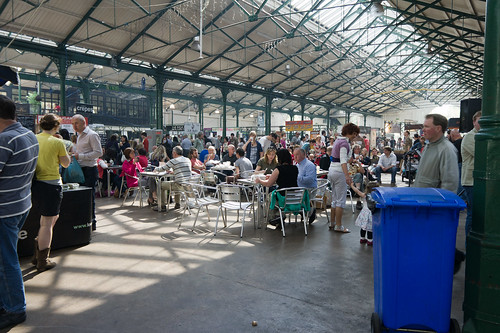
Image by infomatique
This was one of the highlights of my visit to Belfast.
St George’s Market is one of Belfast’s oldest attractions. It was built between 1890 and 1896 and is one of the best markets in the UK and Ireland. It holds a market on Friday, Saturday and Sunday each week. The market sells a variety of products including food, clothes, books and antiques.
St George's Market is the last surviving Victorian covered market in Belfast, Northern Ireland. It is located on May Street, close to the River Lagan and the Waterfront Hall and Central Railway station.
Belfast Corporation (now Belfast City Council) commissioned the building of St George’s Market, which was built in three phases between 1890 and 1896. Before 1890 St George's Market was an open market and most likely contained a slaughterhouse and a meat market.
The original (pre 1890) market was smaller than the new structure. The city surveyor (responsible for the new Albert Bridge following its collapse in the 1880s) JC Bretland designed the building. It was built in red brick with sandstone dressing. Externally it features Roman styled arches with Latin and Irish inscriptions - the City’s Latin motto "Pro Tanto Quid Retribuamus", meaning "what shall we give in return for so much?" and the Irish phrase "Lámh Dearg na hÉireann", "Red Hand of Ireland". The main entrance arch displays the Belfast Coat of Arms. This newly covered market opened to the public on 20 June 1890.
By the 1980s St George’s Market had developed into a general market and it became the last of Belfast’s thriving Victorian markets. The market was pressured with increased maintaince costs and changes to hygiene regulations, among other issues, and Belfast City Council decided to source other uses for the listed building. A campaign backed by the City Council, traders and the general public resulted in a Heritage Lottery Fund-backed £3.5 million refurbishment programme assisted by the Environment and Heritage Agency. Brick and stonework that had badly deteriorated was returned to good condition, and special bricks were produced in England to match the original unusually sized bricks. The fully renovated St George’s Market reopened its doors on 14 May 1999.
St George’s Market is primarily used as a market, however a number of other events are held at the site. These range from food festivals, art initiatives, exhibitions, charity launches, fashion shoots and live music events. Local software company Northbrook Technology hold their annual Staff Christmas Party at the venue.
The market has won a number of recent awards, including being voted as one of the UK's top five markets by the National Association of British Market Authorities in 2006, and winning third place in the best markets category of the Observer Food Monthly/Waitrose Awards in 2004.
The market has also been praised as a place that transcends the divide between Belfast's communities, and where immigrant groups can feel safe, in contrast to other areas of the city where racist attacks are not uncommon.
No comments:
Post a Comment